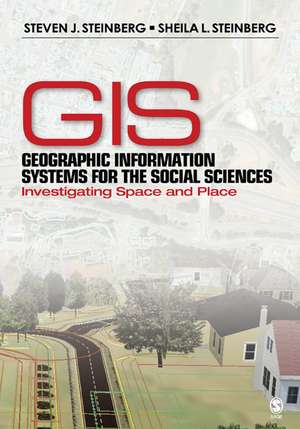Geographic Information Systems for the Social Sciences: Investigating Space and Place
Autor Steven J. Steinberg, Sheila L. Steinbergen Limba Engleză Paperback – 28 sep 2005
| Toate formatele și edițiile | Preț | Express |
|---|---|---|
| Paperback (1) | 913.17 lei 6-8 săpt. | |
| SAGE Publications – 28 sep 2005 | 913.17 lei 6-8 săpt. | |
| Hardback (1) | 1316.69 lei 6-8 săpt. | |
| SAGE Publications – 28 sep 2005 | 1316.69 lei 6-8 săpt. |
Preț: 913.17 lei
Preț vechi: 1250.92 lei
-27% Nou
174.75€ • 189.76$ • 146.79£
Carte tipărită la comandă
Livrare economică 22 aprilie-06 mai
Specificații
ISBN-10: 0761928731
Pagini: 272
Dimensiuni: 178 x 254 x 14 mm
Greutate: 0.49 kg
Ediția:New.
Editura: SAGE Publications
Colecția Sage Publications, Inc
Locul publicării:Thousand Oaks, United States
Cuprins
Organization of this book
Chapter Summaries
Introduction
Social Inequality in Chicago Slums
Railroads as Indicators of Civilized Society
Early Social Ecology: Spatial Studies of Chicago
Relevant Web Sites
1. Introduction to Geographic Information Systems
What is a Geographic Information System?
Understanding GIS
The "G" in GIS
The "I" in GIS
The "S" in GIS
Summary
Relevant Web Sites
2. GIS Basics
An Example of a Spatially-Based Study
GIS Data Formats
Spatial Data Formats
GIS Data Models
Topological and Raster Data Models and Analysis Approaches
Data Compression and Packaging
Essential Mapping Concepts
So What Do I Do?
GIS Output
Summary
Relevant Web Sites
Suggested Reading
3. Topics for Sociospatial Research
Introduction
What Value Does GIS Present in Social Science Research?
Exploring and Integrating Information
Determining Project Goals
Guiding Questions
How To: Steps in the Process
Relevant Web Sites
4. Research Design
Inductive Versus Deductive Approach to Research
What Is the Purpose of Your Research?
Stages of Sociospatial Research for Deductive Research
The Role of Time
Errors in Human Inquiry
Ecological Fallacy
Ethics and GIS
Relevant Web Sites
Suggested Reading
5. Qualitative Research Methods and GIS
Introduction
Grounded Theory: GIS Using an Inductive Approach
Grounded Theory and GIS
Sociospatial Grounded Theory Using GIS
Questions to Guide Integration of GIS Into Field Research
Local Sources of Data
Oral History Interviews
Participant Observation
News as a Source of Data
Ethnography and GIS
Case Studies and GIS
Public Participation and GIS
Relevant Web Sites
6. GIS Data Collection and Development (Sources, Input, and Output)
Introduction
Data Acquisition
Evaluating Data Suitability
Obtaining GIS Data From the Internet
Obtaining Data From Offline Sources
How Can I Use My Own Data?
Approaching the Use of GIS With and Without Computer in the Field
Data Collection Considerations
Unit of Analysis
Database Concepts and GIS
Rules for GIS Database Development
Creating GIS-Friendly Data Tables
Integrating Other Types of Data
GIS Output
Conclusions
Relevant Web Sites
7. Measurement
Introduction
Type of Data Source: Primary or Secondary
Concepts, Variables, and Attributes
Operationalization of Concepts in GIS
Different Data Types: Matching Geographic and Social Variables?
Validity and Reliability
Data Sampling and GIS
Study Area and Sample Unit Boundaries
Factors Affecting Choice of GIS Variables
Relevant Web Sites
Suggested Reading
8. Data Documentation and Model Development
The Importance of Ground Truthing Data
Documenting Data Accuracy and Quality (Metadata)
Analytical Approach
Phases of Abstraction
Statistical Outputs From GIS
Relevant Web Sites
9. Analysis, Interpretation, and Application
Analysis Techniques
Cartographic Classification
Buffer and Overlay
Proximity Polygons and Nearest Neighbors
Social Networks and Network Analysis
Topographic Tools
Spatial Interpolation and Simulation
Modeling
When to Use GIS as a Problem-Solving Tool
Potential Pitfalls
Relevant Web Sites
10. Future Opportunities for Social Research and GIS
Linking GIS and the Social Sciences
Using GIS to Study Society and Change
Identifying Social Inequality
GIS City Case Example
Government and GIS
Data Continuity Over Time
Metadata Documentation of Your Data
Future Directions for GIS and Social Sciences
Visualization and GIS
Faster Response Time
Impact of Tools for the Future
Parting Thoughts
Some Suggestions for Student Research Projects
Relevant Web Sites
Glossary
Web Links
References
Index
Notă biografică
Dr. Steven J. Steinberg is an Associate Professor of Environmental and Natural Resource Sciences at Humboldt State University, Arcata, California. He received his bachelor¿s degree from Kent State University, Ohio; his master¿s from The University of Michigan, Ann Arbor; and his doctorate from The University of Minnesota, Twin Cities. He has been involved extensively in the development and teaching of geographic information systems (GIS) and remote sensing courses in both the university and professional development arenas. Since coming to Humboldt State University, Dr. Steinberg has taught and developed a variety of courses in the area of GIS, remote sensing, and spatial data analysis, with an emphasis on human interactions with social and environmental surroundings. His recent research interests include the development of simple, Web-based spatial analysis tools. He also has interests in the interactions between people and their surroundings through the use of spatial analysis techniques. As cofounder and director of Humboldt State University¿s Advanced Spatial Analysis Facility, Dr. Steinberg has overseen a variety of GIS and spatial analysis projects and research with organizations and government agencies in northern California and elsewhere. He was selected as a Fulbright Scholar for 2004-2005, serving as distinguished chair in airborne remote sensing with the Centre for Scientific Computing at Simon Fraser University, Burnaby, British Columbia, Canada. During 2005-2007, he is participating as part of an interdisciplinary team of scientists at Humboldt State University on a National Science Foundation project extending research experience to undergraduate students in a cross-disciplinary computing modeling and applications environment.









